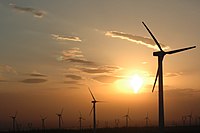
Photo from wikipedia
The rapid rising of renewable energy sources particularly wind energy cannot be ignored. The numerical increase in wind energy farms throughout the world is the best example. The purpose of… Click to show full abstract
The rapid rising of renewable energy sources particularly wind energy cannot be ignored. The numerical increase in wind energy farms throughout the world is the best example. The purpose of this paper is to assess the basic question of whether wind characteristics affect the performance and cost of energy. The importance of this question cannot be ruled out while comparing renewable energy to a conventional form of energy more specifically especially for the developing country where the cost of energy is very high.,The research design of this paper is consists of an assessment of local wind characteristics of the wind farm site using Weibull k and c parameters. The performance model is used to assess the performance of the wind turbine (WT) corresponding to local wind characteristics. The wind correlation with WT in terms of changing wind speed has been assessed to quantify the effects of wind speed on the WT behavior and failure of WT components. Similarly, the power curve of WT is assessed and compared with the International Electrotechnical Commission standards 61400-12-2. The WT power coefficient and tip speed ratio corresponding to wind speed is also investigated. The energy volume and cost of energy lost model is used to determine the cost and volume loss of energy/kWh of the wind farm.,The findings of practical wind farms showed that the wind conditions of the site are showing a strong tendency that can be determined from the results of Weibull k and c parameters. The k and c parameters are observed to be 3.44 and 9.16 m/s, respectively, for a period of a year. The standard deviation is observed to be 2.56 for a period of a year. WT shows the efficient behavior can be obtained from the power coefficient and tip speed of WT at different wind speeds. Also, wind farm observation showed that to be some increasing wind speed cause of based WT component failures. The results of energy volume and cost/kWh assessment showed that the major portion of energy volume and cost of energy is lost owing to network, voltage dip and frequency surge, electrical and mechanical components failures.,Generally, it can be concluded that the WTs are now able to cope with variable wind speeds. However, the results of this paper are showing that WT performance and availability decreased due to increased wind speeds. It can also be a reason to decreased volume and increase the cost of energy/kWh.
Journal Title: International Journal of Energy Sector Management
Year Published: 2020
Link to full text (if available)
Share on Social Media: Sign Up to like & get
recommendations!